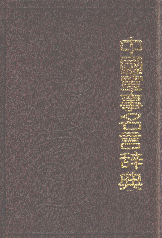中国军事名言辞典
本书编写组编,云南科学技术出版社1989年10月出版。32开,765页。收录军事名言5000余条,并加以注释。所涉人物和书籍,上至先秦,下迄现代,内容包括战争、军建军备、作战谋略、组织指挥、将帅修养、带兵练兵、对敌政策、后方补给等。按首字笔画为序编排。

主要责任者: 熊武一,唐西清,赵群华;欧阳世渊,李维华,黄碧然
责任方式: 主编;副主编
出版者: 云南科技出版社
出版地: 昆明
字数: 800 千字
页码: 1-765
开本: 32
装帧: 精
语种:中
定价:10.80
出版时间:1989-10
丛书多卷书否:否
书目简介:本册工具书共收录4704条词条。
被引频次:1
- 公元1006年(宋真宗景德三年)
- 公元102年(和帝永元十四年)
- 公元1040—1041年(宋仁宗康定元年——二年)
- 公元1069—1070年(宋仁宗熙宁二年——三年)
- 公元106年(殇帝延平元年)
- 公元1072—1074年(宋仁宗熙宁五年一七年)
- 公元107年(安帝永初元年)
- 公元1097年(宋哲宗绍圣四年)
- 公元10年(王莽始建国二年)
- 公元1130年(宋高宗建炎四年)
- 公元1132年(宋高宗绍兴二年)
- 公元1143年(宋高宗绍兴十三年)
- 公元1150年(宋高宗绍兴二十年)
- 公元1163年(宋孝宗隆兴元年)
- 公元1170年(宋孝宗乾道六年)
- 公元119年(安帝元初六年)
- 公元1204年(宋宁宗嘉泰四年)
- 公元1206年(元太祖元年)
- 公元1209年(元太祖四年)
- 公元120年(安帝永宁元年)
- 公元1211年(元太祖六年)
- 公元1218年(元太祖十三年)
- 公元1219年(元太祖十四年)
- 公元1221年(元太祖十六年)
- 公元1223年(元太祖十八年)